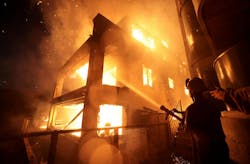Fire Chief Outlines New CA Wildfire Prevention Regulations
OROVILLE — New regulations on defensible space around homes are inbound from the California Board of Forestry and Fire Protection that will tighten rules for homeowners in areas designated as having high fire risk.
Previously, these regulations created zones around homes, the first being 30 feet from the structure and the second running from 30 to 100 feet from a structure. These new regulations would add a third zone within five feet of a home called “Zone 0,” which will come with more standards.
Cal Fire-Butte County Fire Chief Garrett Sjolund said the new rules would phase in over the next three years for existing structures, while new structures would need to be built with the regulations in mind going forward.
“This includes keeping roof gutters and the area within five feet of a home free of leaves and needles, removing combustible material such as firewood and buildings and ensuring that fences and gates attached to buildings must be made of noncombustible materials for the first five feet,” Sjolund said.
Additionally, outbuildings within the zone will need to be non-combustible.
Zone 0 regulations are still in the draft stage and some of the language has yet to be finalized and therefore could be changed. For example, the California Board of Forestry and Fire Protection is still considering the language related to potted plants and trees within five feet of homes. Sjolund said that either well-maintained trees would be universally allowed –or they will be allowed but with the caveat that branches must be 10 feet or more from chimneys.
As far as enforcement goes, it will likely be up to the local municipality or the county to maintain these regulations in the form of hearings and penalties, similar to what currently takes place in the form of liens and public nuisance designations. However, this could change before the law becomes final.
“We believe it’s going to be delegated from the state down to the local level but that has not been adopted yet and the regulation has not been finalized,” Sjolund said.
Who’s affected?
On Tuesday, Sjolund presented the new rules to the Butte County Board of Supervisors, at which time he noted that there are 13,000 structures (homes and outbuildings) in unincorporated parts of the county that are considered to be within the bounds of high fire risk areas. That said, most of these fall under the State Responsibility Area.
This includes census-designated communities such as Cohasset, Forest Ranch, Magalia, Stirling City and beyond.
The entirety of Paradise resides in a high-risk area, as well as portions of Chico, specifically Bidwell Park, and smaller parts of Oroville.
Until it is decided that enforcement will be conducted locally, the draft language, at least in Butte County, points to the state as the responsible party.
“At the time, the way it is written, it will fall on the state to inspect and regulate,” Sjolund said.
Once the law is on the books, any new structures will need to meet the requirements for Zone 0 defensible space in order to build.
The next steps
From here, the state has until Dec. 10 to prepare all emergency rulemaking documents in order to be approved by Jan. 14. From there, the state would open a comment period.
“The notice of rules would come out in late January, of course, they would have to submit the rules to the Office of Administrative Law in January and early February and begin an emergency comment period,” Sjolund said. “And the rules would come into effect in February.”
After that, amendments will be considered and the final product should be in place starting in April.
Sjolund did note that there appears to be a split between recommendations by the state and insurance requirements.
“When we look at this rulemaking, and it has not been finalized yet, there are some discrepancies between what the Board of Forestry is recommending and the Insurance Institute of Business and Home Safety, which is the standard that is put out there for people to get their homes insured. One being the allowance of potted plants or potentially trees next to structures as an example.”
Sjolund continued, “Not having the final rulemaking we don’t know if those two are going to line up correctly, which may cause some confusion for our homeowners when we look at insurance needs versus what the state and Cal Fire will be inspecting.”
© 2025 Chico Enterprise-Record, Calif. Visit www.chicoer.com. Distributed by Tribune Content Agency, LLC.
